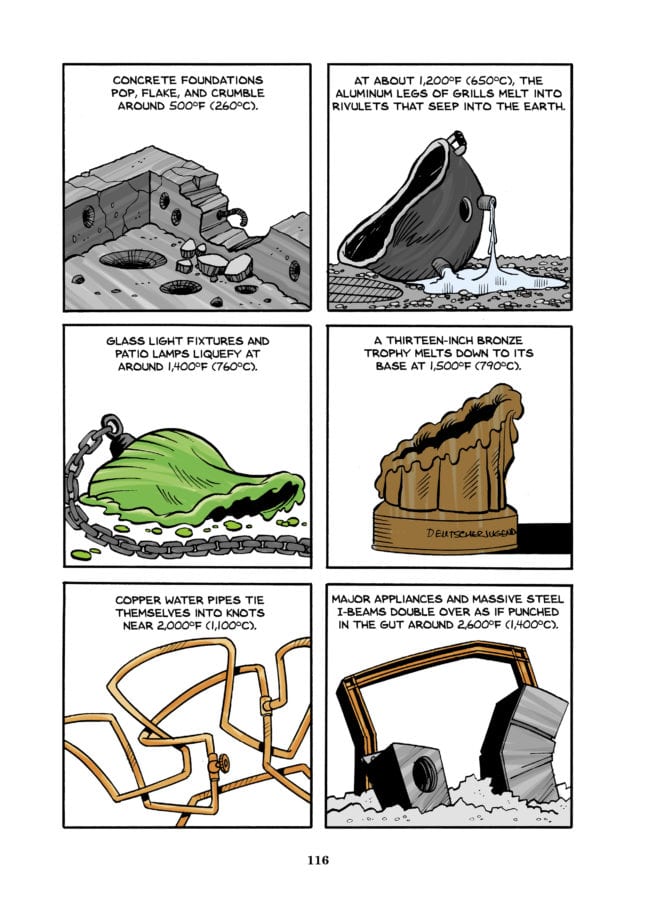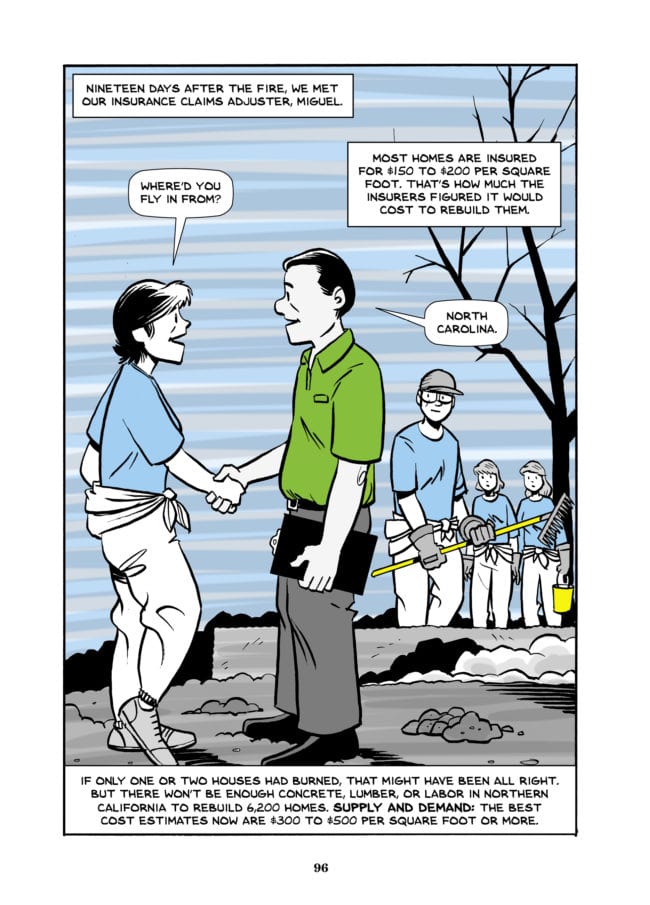When faced with extraordinary circumstances — say, a series of wildfires that would ultimately destroy over 6,200 homes and kill 44 — ordinary people record what’s happening with whatever tools are available.
So what does an Eisner Award winning nonfiction cartoonist do? Brian Fies, of Mom’s Cancer and Whatever Happened to the World of Tomorrow? dashed off an 18 page comic while fires burned through Northern California in late 2017. This comic, drawn with sharpies, writing pens and highlighters and then posted to Fies’ blog, quickly went viral. It would go on to be adapted into an animated video that won a regional Emmy. Reading it again now, it’s easy to see why: the story begins, “ON MONDAY, MY HOUSE DISAPPEARED,” and is full of raw immediacy.
On the first page, after Fies’ name, an asterisk leads to text at the bottom that reads, “but not to his usual standards.” This caveat makes the deft cartooning and vulnerable storytelling that follows all the more impressive. But it also begs the question, what would this be like if it were up to Fies’ standards? The full-length graphic novel version, also titled A Fire Story, came out this March from Abrams ComicsArts. And not only is the book inspired by the original webcomic, it is more or less a faithful recreation.
This extends to the stylistic choices Fies made with the book’s color. Fies uses a limited, fluorescent palette reminiscent of the highlighters he used originally. Each color is shaded in thick bands of various opacities — the result looks like the streaks left by Crayola markers. The characters are mostly in grayscale. I found the contrast between the grays and the loud, striped accent colors to be distracting and somewhat ineffective. However, Fies’ experience as an artist is evident in the top-notch compositions and facial expressions throughout.
 The book’s chronology bounces around a little, but its scenes, where continuous action tells the story, are its best moments. The sequence where Fies first returns to his burned-down neighborhood, feels as powerful as it does in the original webcomic. Similarly, the scene where his family, clad in protective gear, sifts through the charred remains of the house is emotionally potent and well-told. There are several parts that moved me to tears, as you might expect from a narrative about a family in extremis.
The book’s chronology bounces around a little, but its scenes, where continuous action tells the story, are its best moments. The sequence where Fies first returns to his burned-down neighborhood, feels as powerful as it does in the original webcomic. Similarly, the scene where his family, clad in protective gear, sifts through the charred remains of the house is emotionally potent and well-told. There are several parts that moved me to tears, as you might expect from a narrative about a family in extremis.
And there were interesting details I did not expect: what happens to a community’s mail when there’s suddenly nowhere to deliver it to, how burned down houses become hazardous waste sites, how different household materials melt in different ways and at different temperatures.
 This book finds me in an unusual place. My mom just had a fire in her basement bad enough that she’s not allowed to live there, and I also just bought a house with my wife this last fall. We haven’t even lived here a full year yet and I couldn’t imagine it burning down. Fire is scary, and elemental, but it’s all too common. Fies’ book is a reminder of how quickly disaster can change your life. (Test your smoke detectors! Make sure you have a fire extinguisher and know how to use it!)
This book finds me in an unusual place. My mom just had a fire in her basement bad enough that she’s not allowed to live there, and I also just bought a house with my wife this last fall. We haven’t even lived here a full year yet and I couldn’t imagine it burning down. Fire is scary, and elemental, but it’s all too common. Fies’ book is a reminder of how quickly disaster can change your life. (Test your smoke detectors! Make sure you have a fire extinguisher and know how to use it!)
And while the book is quite a document of Fies’ experience and a good read in the process, I wonder if it accomplishes its own goals. In the afterword, referring to the original webcomic, Fies writes, “I’ve done journalism before, and A Fire Story felt like journalism to me.” I myself featured it in my newsletter about journalistic webcomics. The book version certainly has many of the hallmarks of professional journalism...but as has been noted elsewhere, men’s memoirs often get rounded up to journalism and women’s journalistic books often get rounded down to memoirs. So: is A Fire Story good journalism?
 The book is about 90% personal narrative with little outside context. Fies’ most straightforward effort to bring in outside perspectives is through the inclusion of five “fire stories” throughout: first-person prose accounts of other fire victims. These sections serve as chapter breaks and read like oral histories. Unfortunately, this is a half measure at best. The stories, without context, become simply anecdotal. The reader has no way to appreciate how relevant these stories are to the larger disaster.
The book is about 90% personal narrative with little outside context. Fies’ most straightforward effort to bring in outside perspectives is through the inclusion of five “fire stories” throughout: first-person prose accounts of other fire victims. These sections serve as chapter breaks and read like oral histories. Unfortunately, this is a half measure at best. The stories, without context, become simply anecdotal. The reader has no way to appreciate how relevant these stories are to the larger disaster.
It is also clear that Fies, quite understandably, was still processing his own trauma while writing the book. Recently, Fies put a note on his blog that he and his wife just moved back into their rebuilt house. It’s clear from the book that he has as strong a support system of family and friends as anyone could. I’m sincerely happy for him and hope that he can continue to put these events behind him.
 I wonder if the book may have benefited from another few months of contemplation. At several points, Fies hints at large, systemic problems, including with the insurance industry, climate change and the emergency alert systems. But the book is not equipped to investigate these issues with any depth, as it is primarily focused on the specifics of Fies’ experience.
I wonder if the book may have benefited from another few months of contemplation. At several points, Fies hints at large, systemic problems, including with the insurance industry, climate change and the emergency alert systems. But the book is not equipped to investigate these issues with any depth, as it is primarily focused on the specifics of Fies’ experience.
Frankly, A Fire Story is good memoir and inadequate journalism. And there is plenty of great wildfire journalism, from Lizzie Johnson’s reporting for the San Francisco Chronicle to the many longform classics. As far as I know, there just isn’t a definitive nonfiction comic account of a wildfire yet. This book is A Fire Story, not “the fire story.”







